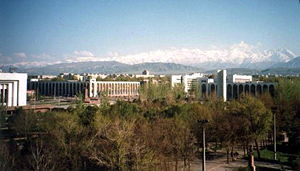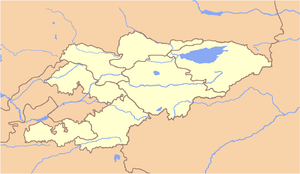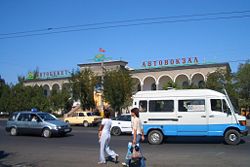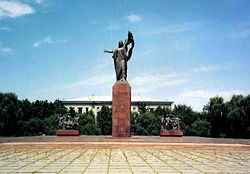Bishkek
| Bishkek Бишкек |
|||
| Bishkek cityscape | |||
|
|||
| Location in Kyrgyzstan | |||
| Coordinates: {{#invoke:Coordinates|coord}}{{#coordinates:42|52|29|N|74|36|44|E|type:city | |||
|---|---|---|---|
| name= }} | |||
| Country | | ||
| Province | |||
| Founded | 1878 | ||
| Government | |||
| - Mayor | Daniyar Usenov | ||
| Population (2005 est.) | |||
| - Total | 900,000 | ||
Bishkek (Russian and Kyrgyz: Бишкек) is the capital and the largest city of Kyrgyzstan.
Somewhat confusingly, Bishkek is also the administrative center of Chuy Province which surrounds the city, even though the city itself is not part of the province but rather a province-level unit of Kyrgyzstan.
Founded in 1878 as the Russian fortress of Pishpek (Пишпек), between 1926 and 1991 it was known as Frunze (Фрунзе), after the Bolshevik military leader Mikhail Frunze.
Bishkek is a city of wide boulevards and marble-faced public buildings combined with numerous Soviet-style apartment blocks surrounding interior courtyards and, especially outside the city center, thousands of smaller privately built houses. It is laid out on a grid pattern, with most streets flanked on both sides by narrow irrigation channels that water the innumerable trees which provide shade in the hot summers.
Geography
The name is thought to derive from a Kyrgyz word for a churn used to make fermented mare's milk (kumis), the Kyrgyz national drink.
Bishkek is situated at about 2624 feet (800 meters) altitude just off the northern fringe of the Ala-Too range, an extension of the Tien Shan mountain range, which rises up to 15,748 feet (4800 meters) and provides a spectacular backdrop to the city. North of the city, a fertile and gently undulating steppe extends far north into neighboring Kazakhstan. The Chui river drains most of the area. Bishkek is connected to the Turkestan-Siberia Railway by a spur.
Temperatures in Bishkek range from -8.3F (-22.4°C) in January to 68°F (20.1°C) in July. Rainfall varies from one inch (24mm) to 6.8 inches (174mm) a month.
Bishkek is located the Alaarcha and Alamedin rivers and the (Great) Chuysky Canal.
Size – land area, size comparison Environmental issues Districts
History
Originally a caravan rest stop (possibly founded by the Sogdians) on one of the branches of the Silk Road through the Tien Shan range, the location was fortified in 1825 by the Uzbek khan of Kokhand with a mud fort.
In 1862, the fort was conquered and razed when Tsarist Russia annexed the area. The site became a Russian garrison and was redeveloped and named Pishpek from 1877 onward by the Russian government, which encouraged the settlement of Russian peasants by giving them fertile black soil farms to develop. In 1926, the city became the capital of the newly established Kirghiz ASSR and was renamed Frunze after Mikhail Frunze, Lenin's close associate who was born in Bishkek and played key roles during 1905 and 1917 revolutions and during the Russian civil war of the early 1920s. The early 1990's were tumultuous. In June 1990, a state of emergency was declared following severe riots in southern Kyrgzystan which threatened to spread to the capital. The city was renamed Bishkek in early 1991 and Kyrgyzstan achieved independence later that year during the breakup of the Soviet Union. Today, it is a vibrant, rapidly modernizing city, with many restaurants and cafes and lots of second-hand European and Japanese cars and minibuses crowding its streets. At the same time Bishkek still preserves the charm of a Soviet Central Asian city, with Soviet-period buildings and gardens lovingly maintained, instead of being torn down and replaced by newer structures.
Bishkek is also the country's financial center, with all of the country's 21 commercial banks featuring offices in the city. During the Soviet era the city was home to a large number of industrial plants, but most have been shut down or operate today on a much reduced scale. One of today's Bishkek's largest employment centers is Dordoy Bazaar, which is one the major entrepots for Chinese goods imported into CIS countries.
In 2002, the United States obtained the right to use the nearby Manas International Airport as an air base for its military operations in Afghanistan and Iraq. Russia subsequently (2003) established an air base of its own (Kant Air Base) near Kant some 20 km east of Bishkek. It is based at a facility that used to be home to a major Soviet military pilot training school; one of its students, Hosni Mubarak, later became president of Egypt.
Government
The politics of Kyrgyzstan take place in a framework of a semi-presidential representative democratic republic, whereby the president is head of state and the prime minister is head of government, and of a multi-party system that is in development. Executive power is exercised by the government. Legislative power is vested in both the government and parliament.
Local government is administered by the Bishkek Mayor's Office. Askarbek Salymbekov was mayor until his resignation in August 2005, following which his deputy Arstanbek Nogoev took over the mayorship. Nogoev was in turn removed from his position in October 2007 through a decree of President Kurmanbek Bakiyev and replaced by businessman and former first deputy prime minister Daniyar Usenov.
Economy
Overview – Any specialization: For instance, is a manufactured product is associated with particular cities a. Milwaukee—cheese and beer b. Los Angeles—entertainment industry c. Sheffield—coal d. top 20 cities in the U.S. are highly specialized Per capita GDP, rank Financial and business services sector Tourism Manufacturing Transport: Road, rail, air, sea
There is public transportation available, including buses, trolley buses, and public vans (known as marshrutkas). Streetcars (trams) also run along selected routes. Taxi cabs can be found at every intersection. There is no subway in Bishkek. The city is considering designing and building a light rail system (Бишкекское лёгкое метро).
There are two main bus stations in Bishkek. The smaller old Eastern Bus Station is primarily the terminal for minibuses to various destinations within or just beyond the eastern suburbs, such as Kant, Tokmok, Kemin, Issyk Ata, or the Korday border crossing.
Long-distance regular bus and minibus services to all parts of the country, as well as to Almaty (the largest city in neighboring Kazakhstan) and Kashgar, China, run mostly from the newer grand Western Bus Station; only a smaller minority of them runs from the Eastern Station.
The Dordoy Bazaar on the north-eastern outskirts of the city also contains makeshift terminals for frequent minibuses to suburban towns in all directions (from Sokuluk in the west to Tokmak in the east) and to some buses taking traders to Kazakhstan and Siberia.
As of 2007, the Bishkek railway station sees only a few trains a day. It offers a popular three-day train service from Bishkek to Moscow.
There are also long-distance trains that leave for Siberia (Novosibirsk and Novokuznetsk), via Almaty, over the Turksib route, and to Yekaterinburg (Sverdlovsk) in the Urals, via Astana. These services are particularly slow, since the trains first have to go west for more than a hundred kilometers before they enter the main Turksib line and can continue to the east or north.
The city is served by Manas International Airport located approximately 25 km (16 mi) northwest of the city centre.
Demographics
Population, population rank Race/ethnicity - historical background of ethnic groups Language Religion Colleges and universities
Of interest
Though the city is relatively young, the surrounding area has sites of interest dating from prehistory, the Greco-Buddhist period, the period of Nestorian influence, the era of the Central Asian khanates, and the Soviet period.
The central part of the city is mostly built on a rectangular grid plan. The city's main street is the east-west Chui Avenue (Prospekt Chui), named after the region's main river. In the Soviet era, it was called Lenin Ave. Along it, or within a block or two from it, many of the most important government buildings, universities, the Academy of Sciences compound, etc., are to be found. The westernmost section of the avenue is known as Deng Xiaoping Ave.
The main north-south axis is Yusup Abdrakhmanov Street, still (2007) commonly referred to by its old name, Sovietskaya St. Its northern and southern sections are called, respectively, Yelebesov St and Baityk Batyr St. Several major shopping centers are located along it, and in the north it provides access to Dordoy Bazaar.
Erkindik ('freedom') Boulevard runs north-south, from the main railroad station (Bishkek II) south of Chui Ave to the museum quarter and sculpture park just north of chui Ave, and further north toward the Ministry of Foreign Affairs. In the past, it was called Dzerzhinsky Blvd. (named after Communist revolutionary, Felix Dzerzhinsky) and its northern continuation is still called Dzerzhinksy Street.
An important east-west street is Jibek Jolu ('Silk Road'). It runs parallel to Chui Ave. about a mile north of it, and is part of the main east-west road of Chui Province. Both the Eastern and Western bus terminals are located along Jibek Jolu.
- State Historical Museum, located in Ala-Too Square, the main city square
- State Museum of Applied Arts, containing examples of Kyrgyz traditional handicrafts
- Frunze House Museum
- Statue of Ivan Panfilov stands in the park near the White House.
- An equestrian statue of Mikhail Frunze still stands in a large park (Boulevard Erkindik) across from the train station.
- The train station itself was built in 1946 by German prisoners of war and has survived since then without further renovation or repairs; most of those who built it perished and were buried in unmarked pits near the station.
- The main government building, the White House, is a huge seven-story marble block and the former headquarters of the Communist Party of the Kirghiz SSR
- At Ala-Too square, there is an Independence monument where the changing of the guards may be watched.
- The Osh market, west of downtown, is a large picturesque produce market
Outer neighborhoods
- The Dordoy Market, just inside the bypass highway on the north-eastern edge of the city, is one of Asia's great retail and wholesale markets.
Outside of the city
- The Ala-Too mountain range, 40 km away, provides a spectacular backdrop to the city; the Ala Archa National Park is only 30-45 min drive away
See also
- Names of Asian cities in different languages
ReferencesISBN links support NWE through referral fees
External links
- Travel guide to Bishkek from Wikitravel
Template:Districts of Kyrgyzstan
| |||||||||||||||||
Credits
New World Encyclopedia writers and editors rewrote and completed the Wikipedia article in accordance with New World Encyclopedia standards. This article abides by terms of the Creative Commons CC-by-sa 3.0 License (CC-by-sa), which may be used and disseminated with proper attribution. Credit is due under the terms of this license that can reference both the New World Encyclopedia contributors and the selfless volunteer contributors of the Wikimedia Foundation. To cite this article click here for a list of acceptable citing formats.The history of earlier contributions by wikipedians is accessible to researchers here:
The history of this article since it was imported to New World Encyclopedia:
Note: Some restrictions may apply to use of individual images which are separately licensed.





